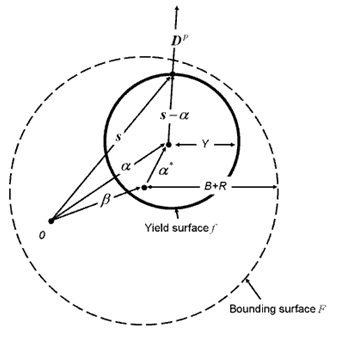/MAT/LAW78
Block Format Keyword This law is the Yoshida-Uemori model for describing the large-strain cyclic plasticity of metals. The law is based on the framework of two surfaces theory: the yielding surface and the bounding surface.
During the plastic deformation, a yield surface will move within the bounding surface and will never change its size, and the bounding surface can change both in size and location. The plastic-strain dependency of the Young's modulus and the work-hardening stagnation effect are also taken into account. Concerning SPH, it is compatible with solid only, this can be verified with the /SPH/WavesCompression test. The solid version is only isotropic. The shell version is anisotropic based on Hill criterion.
Format
| (1) | (2) | (3) | (4) | (5) | (6) | (7) | (8) | (9) | (10) |
|---|---|---|---|---|---|---|---|---|---|
| /MAT/LAW78/mat_ID/unit_ID | |||||||||
| mat_title | |||||||||
| ρi | |||||||||
| E | ν | ||||||||
| Y | b | C | h | B0 | |||||
| m | Rsat | OptR | C1 | C2 | |||||
| r00 | r45 | r90 | |||||||
| fct_IDE | Einf | CE | |||||||
Definitions
| Field | Contents | SI Unit Example |
|---|---|---|
| mat_ID | Material identifier (Integer, maximum 10 digits) |
|
| unit_ID | Unit Identifier (Integer, maximum 10 digits) |
|
| mat_title | Material title (Character, maximum 100 characters) |
|
| ρi | Initial density (Real) |
[kgm3] |
| E | Young's modulus (Real) |
[Pa] |
| ν | Poisson's ratio (Real) |
|
| Y | Yield stress (Real) |
[Pa] |
| b | Center of the bounding
surface. (Real) |
[Pa] |
| C | Parameter for kinematic hardening rule
of yield surface. (Real) |
|
| h | Material parameter for controlling work
hardening stagnation. (Real) |
|
| B0 | Initial size of the bounding
surface. (Real) |
[Pa] |
| m | Parameter for isotropic and kinematic
hardening of the bounding surface. (Real) |
|
| Rsat | Saturated value of the isotropic
hardening stress. (Real) |
[Pa] |
| OptR | Modified isotropic hardening rule flag
(available for shells only):
(Integer) |
|
| C1, C2 | Constant used in the modified
formulation of the isotropic hardening of bounding surface (available for shells
only). (Real) |
|
| r00, r45, r90 | Material parameters determining
anisotropy in Hill's (48) yield criterion (in shell version). Default = 1.0 (Real) |
|
| fct_IDE | ID of the function defining the scale
factor of Young's modulus evolution versus effective plastic strain. 7 (Integer) |
|
| Einf | Asymptotic value of Young's
modulus. (Real) |
[Pa] |
| CE | Parameter controlling the dependency of
Young's modulus on the effective plastic strain. (Real) |
Example
#RADIOSS STARTER
#---1----|----2----|----3----|----4----|----5----|----6----|----7----|----8----|----9----|---10----|
/UNIT/1
unit for mat
Mg mm s
#---1----|----2----|----3----|----4----|----5----|----6----|----7----|----8----|----9----|---10----|
#- 2. MATERIALS:
#---1----|----2----|----3----|----4----|----5----|----6----|----7----|----8----|----9----|---10----|
/MAT/LAW78/1/1
DP600-HDG
# RHO_I
7.8E-9
# E NU
206000 .3
# Y B C H B0
420 112 200 0 555
# m RSAT OPTR C1 C2
12 190 0 1 1
# R0 R45 R90
1 1 1
# fct_IDE EINF CE
0 1 163000
#---1----|----2----|----3----|----4----|----5----|----6----|----7----|----8----|----9----|---10----|
#ENDDATA
/END
#---1----|----2----|----3----|----4----|----5----|----6----|----7----|----8----|----9----|---10----|Comments
- For solid
elements, von Mises yield criterion is used, so the yield function is expressed
as:
(1) f=32(s−α):(s−α)−Y2Whereas for shell elements, Hill's (48) yield criterion is used, which allows modeling anisotropic materials and it is expressed as:(2) f=φ(σ−α)−Y2Where, ( φ ) is expressed as:(3) φ(A)=A2xx−2r01+r0AxxAyy+r0(1+r90)r90(1+r0)A2yy+r0+r90r90(1+r0)(2r45+1)A2xy - Yield stress, Poisson ratio and Young's modulus should be strictly positive. The other parameters should be non-negative value.
- The schematic illustration of the
two-surface model is shown in Figure 1.
Where, 0 is the original center of the yield surface, the yield surface with its center α and its radii Y, is moving kinematically, within a bounding surface that has a size indicated by B+R and tensor β indicating its center position.Figure 1. Schematic Drawing of the Two-surface Model

- The yield surface is subjected
to a kinematic hardening. The kinematic motion is described by
α*
that has the following evolution:
- ˙α*=C[(aY)(σ−α)−√a‖α*‖α*]˙ˉεp
- for shell elements
- ˙α*=C[(23)a˙εp−√a‖α*‖α*˙ˉεP]
- for solid elements
Where,- ˙ˉεp is the equivalent plastic strain rate
- C and a are material parameters. And a=B+R−Y
- α=α*+β is the total back stress
- The bounding surface is
subjected to an isotropic-kinematic hardening. The evolution equation for isotropic
hardening is:
- ˙R=m(Rsat−R)˙ˉεp
- Default (if OptR = 0) Yoshida expression
- R=Rsat[(C1+ˉεp)C2− CC21]
- Available for shell elements, if OptR = 1
The evolution equation for kinematic hardening of bounding surface is:(4) ˙β=m(23b˙εp−β˙ˉεp) - The
work-hardening stagnation during unloading is described using a
J2-type surface
gσ
with a radius r and a center
q:
(5) gσ(β,q′,r)=32(β−q′):(β−q′)−r2˙q′=μ(β−q′)r=h˙Γ ,˙Γ3(β−q′):˙β2rWhere, β should be either inside or on the surface gσ .
- The evolution of Young's modulus:
- If fct_IDE > 0, the curve defines a scale factor for Young's modulus
evolution with equivalent plastic strain, which means the Young's modulus is scaled by
the function
f(ˉεp)
:
- E(t)=E⋅f(ˉεp)
The initial value of the scale factor should be equal to 1 and it decreases.
-
If fct_IDE = 0, the Young's modulus is calculated as:
(6) E(t)=E−(E−Einf)[1−exp(−CEˉεp)]Where,
E and Einf are respectively the initial and asymptotic value of Young's modulus, ˉεp is the accumulated equivalent plastic strain.
Note: If fct_IDE = 0 and CE = 0, Young's modulus E is kept constant.
- If fct_IDE > 0, the curve defines a scale factor for Young's modulus
evolution with equivalent plastic strain, which means the Young's modulus is scaled by
the function
f(ˉεp)
:
- This material law is not available for implicit analysis.